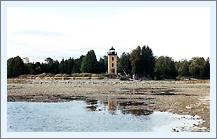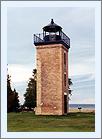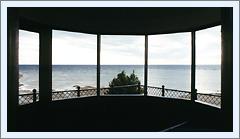 |
 |
 |
| Click thumbnails to view enlarged images | ||
| Point Peninsula Lighthouse | Seeing The Light |
|
|
|
|
Historical Information Author's note - While almost all recent lighthouse books, magazine articles and websites use the name "Peninsula Point" in referring to this light station, all government documents from the 1856 House Journal through the last Great Lakes Lighthouse list in which the station appeared as an active aid to navigation in 1934 refer to the station as as "Point Peninsula." Since the Federal Government owned and named the station, I have used this name throughout the following history. As the southernmost extension of the Niagara Escarpment, Stonington Peninsula juts from the North shore of Lake Michigan before disappearing beneath the water's surface to reappear some twenty miles to the south as the northern tip of Wisconsin's Door Peninsula. With the best passage between Lake Michigan and Escanaba being through St. Martin Island passage, vessel masters making the passage under darkness were forced take extreme care as they rounded Point Peninsula to avoid the shoals which extended from the point some two miles into the lake.
It would appear that problems in obtaining title to the site were experienced, as construction of the new station was never undertaken, and the unexpended appropriation reverted to the Treasury Department. While no mention of the station appears in subsequent Lighthouse Board documentation, the need for lighting Point Peninsula had in no way diminished in the maritime community. Almost ten years after the recall of the original appropriation, Wisconsin Senator Timothy Otis Howe again introduced a bill in the Senate calling for the Committee on Commerce to "inquire into the expediency of building a light-house on Point Peninsula" on February 1, 1864. The Committee on Commerce concurred with the need for the station, and a new appropriation was approved on July 2, 1864.
The District Lampist arrived at the station and carefully installed the station’s new flashing white Fourth Order Fresnel lens atop a cast iron pedestal at the center of the lantern. Situated 36 feet above the tower foundation, the lens sat at a focal plane of 41 feet above lake level, with its single white flash every 30 seconds visible for a distance of 12 miles at sea under clear weather conditions.
In his inspection of the station the following year, Eleventh Lighthouse District Engineer General William F. Raynolds reported that other than a crack which had developed in the front wall of the dwelling and poor drainage causing excessive dampness in the cellar, the station was in good condition. This same year, two spar buoys were established off the point. One was anchored to mark the end of the spit that extended directly from shore, and the other to mark Eleven-Foot Shoal, which lurked a mere 10 1.2 feet below the lake surface approximately 2 ½ miles offshore. After twenty years of service as keeper of the Point Peninsula light, Charles Beggs passed away at the station on February 14, 1887, and Henry Corgan, who had been serving as Assistant Keeper at Gull Rock on Lake Superior, was transferred-in to replace Beggs. 1887 also represented a key year for the long-term survival of the Point Peninsula light. In analyzing traffic patterns in the area, Ninth District Engineer Major Samuel M. Mansfield determined that a light on Eleven-Foot Shoal was key to shipping safety, and suggested that with the establishment of a such light on the shoal, the Point Peninsula light could be rendered obsolete. To this end, the Lighthouse Board requested an appropriation of $60,000 for the establishment of an offshore crib light on the shoal in its annual report for 1888. The very next year, the Board found itself in somewhat of a quandary.
Congress made its reticence to absorb the cost of the new light on Eleven-Foot Shoal clear in 1889 by approving the expenditure for repairs to the dock at Point Peninsula in the sundry civil appropriations act of March 2. However, convinced of the validity of its request for the new offshore light, the repairs remained unmade. As had been the case with Corgan before him, Knudsen’s stay at Point Peninsula was short, and he accepted a transfer to Chambers Island on August 19, 1889. As First Assistant at South Manitou, James D. Armstrong took advantage of the opportunity for promotion and extra pay, accepting the offer of a transfer to Point Peninsula, where he would hold the title of Acting Keeper until he was promoted to full Head Keeper status effective July 5, 1890. Somewhat surprisingly, Congress came through with the requested $60,000 appropriation for a light on Eleven-Foot Shoal on August 30, 1890, and current Ninth District Engineer Major William Ludlow began to formulate plans for the new station. However, it soon became apparent that the $60,000 requested by Major Mansfield three years previous was wholly insufficient for the project. With light vessels needed at a number of locations throughout the Great Lakes, Ludlow suggested that the $60,000 could be put to better use to build three or four unpowered lightships, with one of them to be anchored over Eleven-Foot Shoal. Supporting Ludlow’s suggestion, the Lighthouse Board requested the redirection of the funds, to which Congressional gave approval in the sundry civil appropriations act of August 5, 1892. With approval thus in hand, the Board instructed the Inspectors in all three Great Lakes Lighthouse Districts to form a committee with representatives of the Lake Carriers Association and other maritime interests to identify appropriate locations for the new vessels.
While the Lighthouse Board had stated that the establishment of a light on Eleven-Foot Shoal would render the Point Peninsula light obsolete, the station continued to remain an active aid to navigation, and thus Keeper Armstrong got to keep his assignment. In fact, over the next five years a number of improvements to the station were undertaken. In 1898, a new brick-lined well was driven to supply the kitchen and a 100-foot long trench blasted through the rock from the dwelling out to the lake, a sewer crock was installed to allow water to drain from the kitchen sink. In 1902, a work crew arrived at the station to undertake major renovations. By the following year, a pair of dormers had been added on each side of the roof to allow more light to enter the bedrooms and to increase the living space. The tower was significantly modified through the enlargement of the upper window and metal handrails were installed in the stairway, and an existing small brick outbuilding was enlarged to serve as an oil storage building. Finally, the District Lampist removed the lens chariot, which served as the rotating point for the lens assembly, and replaced the mechanism with an improved ball bearing assembly, allowing the lens to rotate with significantly less friction.
With numerous successful automation projects throughout the district under its belt, the Lighthouse Service made the decision to automate the Peninsula light station with the installation of an acetylene system in 1922. The Fourth Order lens was removed from the lantern and replaced by a 300mm lens equipped with a 300-candlepower acetylene flasher and sun valve. With this installation, the characteristic of the light was changed to repeated 1-second flash followed by a nine-second eclipse, which was exhibited for the first time on the evening of May 20, 1922. While this automation eliminated the need for a full time keeper at the station, for reasons we have as yet been unable to ascertain, Captain Armstrong remained at Point Peninsula until August 8, 1925, when he accepted a transfer to Escanaba as keeper of the Sand Point light station.
By the 1930’s the shipping lanes off Point Peninsula had shifted so far south that they were turning off Minneapolis Shoal, which sat 6 ¾ miles southwest of Point Peninsula. To mark the shoal, the Lighthouse Service obtained an appropriation for construction of a crib light on the shoal in 1932, and work on the new light was completed in 1934. Two years later, with the light at Point Peninsula light no longer serving as a viable aid to navigation, the Point Peninsula light was decommissioned and its light permanently extinguished.
The station has been incorporated part of the Hiawatha National Forest, and the Park continues to maintain the tower and the grounds as a public picnic area. All glass and doors have been removed from the tower, and the public is free to climb the tower and enjoy the lantern view. The park now serves as a premium spot to view the annual September migration of monarch butterflies which gather to feed on the point before winging their way across Green Bay to the Door Peninsula, and their remarkable flight south to winter in Mexico. Keepers of
this
Light Finding this
Light Reference Sources |